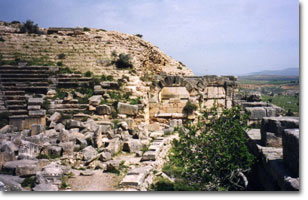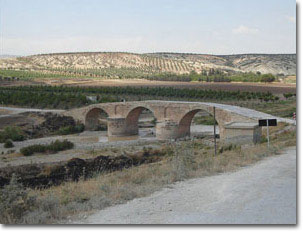|
Located at a distance of 76 km north of Aleppo, close to the Turkish border is the site of the city of Cyrrhus, in Arabic known as Nabi Huri.
It was first founded by Seleucos Nicator, one of Alexander the Great generals, in 300 BC. Cyrrhus was the name of a city in Macedonia. In the 1st century BC, the Armenians from the north occupied it and it became part of their kingdom, until Pompey got it back in 64 BC. It became quite an important military and administrative center and it flourished as it had the commercial advantage of being on the trading route from Antioch to the Euphrates. Most cities in the region were relying more on agriculture-related power.
This town was taken over twice by the Persians in the 3rd century AD, but it remained very Roman and had a significant role in the Christian era. In the 6th century it was refortified and strengthened by Justinian, but fell to the Arabs in 637.
The Crusaders occupied it at the beginning of the 11th century, and it was made dependent on Edessa. In 1150 it was finally taken back by the Arabs again under Nūr al Din, but since then it has lost its strategic importance and was abandoned. The site is now virtually uninhabited though the area is being developed for olive farming.
A lot of the city has been subjected to earthquakes that have hit the region through history, and there have been a few restoration projects to renovate parts of this dead city.

Roman Bridges Roman Bridges
On the road to Cyrrhus are two remarkable little Roman bridges of the 2nd century AD, which still carry vehicles. Though much modified in Byzantine and Arab times, the construction is basically late Roman, a singular tribute to the era's engineering skills.
Cardo Maximus
The city itself has a grid like plan much like all Seleucid and Roman cities. It is centered by the Cardo Maximus, a colonnaded long street that runs very accurately from North to South. It's 7 m wide and paved with basalt. At the southern end of the cardo, a monumental gate formed one of the principal entrances to the city. Lower down the valley, near the northern gate, are some sketchy remains of a church and a basilica.
The Theater
Most important of the vestiges in Cyrrhus is the theater, which is almost 112 meters in diameter and dates back to the 2nd century AD. It is after Apamea (139 m) in the list of largest theaters and a little larger than the contemporary Bosra theater (102 m).
Other vestiges, including the citadel, date back to the Hellenistic period, although most of what is seen today dates back to Justinian's refortifications in the 6th century, and a Roman tower tomb which dates back to the 2nd or 3rd century AD. |


